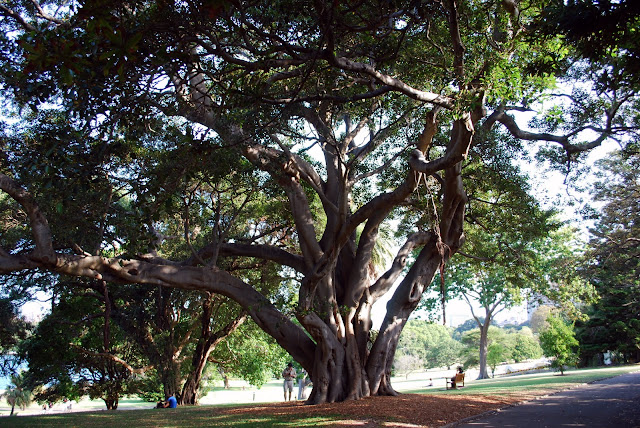I have been showing photos from a trip that my husband and I took to Sydney, Australia last week. I already showed the beautiful and iconic Sydney Opera House, and my full day of traveling all over the city of Sydney on the "hop on and hop off" sightseeing bus while my husband was at work, as this was a business trip for him. One of the most magnificent sights I saw in the beautiful city of Sydney was a portion of The Royal Botanical Gardens. A portion was located right across the street from the hotel where we were staying, and I liked to sit out on the balcony to watch the sun come up and listen to the birds chirping in the morning. (All photos will enlarge if clicked on once and then clicked on again when they re-open)
The photo above is The Palace Garden Gate located at Macquarie Street, between Bridge Street and Bent Street. This ornamental gate was built in 1889 to commemorate the International Exhibition.
The seventy-five acre Royal Botanical Gardens is managed by the same trust as The Domain adjoining it, is free to access and open every day of the year. It is in close proximity to the downtown business center as you can see from the photo above. PDF maps of the garden's large grounds can viewed on this link. The gardens were established in 1816 by Governor Macquarie on the site of the first farm in the colony.
The fountain in the photo above is dedicated to Captain Arthur Philip, RN, (1738-1814), First Governor of New South Wales. Fountain and statue are by the Italian sculptor Achille Simonetti, erected in 1897.
One of the two mini gardens I saw at this location was the Rose Garden and Pavilion and the Pioneer Garden. The Palace Rose Garden contains around 1800 roses. Even though we were in Sydney during the last days of the Southern Hemisphere summer, there was quite a bit of verdant green and flowering shrubs and plants still visible.
The gardens contain over 7,500 species of trees, flowers and shrubs.
Some of the flowers I saw while visiting the gardens
They were also full of many different kinds of birds, many of which were exotic to me!
The cockatoo playing in the water fountain (middle left )was such an enjoyable sight to see, and some day I'll show the entire series of photos I took of him. The baby ducklings making their way to a pond (top left) were also delightful!
Memorial Garden to Pioneers was part of the 150th anniversary celebrations of Australia in 1938, this garden was built on the site of the central dome of the Garden Palace. The massive Palace, opened in 1879, was completely destroyed by fire in 1882.
A close up of the fountain
The Herb Garden and Garden Terrace
Meandering paths lead to so many wonderful sections of the gardens.
The Tropical Center
The Main Pond
The Oriental garden is a serene location by the ponds edge with an Oriental inspired landscaped setting. It contained wild and cultivated plants from warm-temperate and sub-tropical areas of China, Japan, Vietnam, Korea, Taiwan and Bhutan.
The Succulent Garden displays desert landscapes and are a mosaic of colors, shapes and textures. .
A glympse of the nearby Sydney harbor can be seen in this photo.
The Woolloomooloo Gate
The main southern entrance to the Domain was used by Governors and their suites as they strolled from St James Church to the Botanic Garden in the 1840s. An elaborate sandstone gate was erected in 1873, at the junction of Fig Tree Avenue and Central Avenue in the Domain. This entrance gate was moved during the construction of the Cahill Expressway to its present position on Mrs Macquaries Road. One aspect of the garden that astounded me were the abundance of large, mature, and magnificent trees!
One tree was more spectacular than the other!
The fragrance of the Eucalyptus trees floated through the air.
There were many benches throughout the gardens to sit and pause and enjoy their beauty.
One thing we were told not to miss seeing was evident in this tree! Can you what they were? (double click to enlarge the photo)
Bats!
Close up of a Grey-Headed Flying Fox Bat!
The Grey-Headed Flying Fox Bats are completely harmless as they eat only fruit and portions of plants such as pollen and nectar. The Grey-headed Flying-fox is a native species that is endemic to Australia.
Flying-foxes are essential in maintaining many ecosystems because they are able to move pollen and seeds over long distances and across cleared ground, thus linking patches of native vegetation. It has the longest wingspan of any bat with a maximum wingspan of about three feet (one meter). Its body length is normally between 8.5 to 10.5 inches (22 and 27 centimeters.)
I sent my husband over to the garden one evening to do a short Flip film of the bats hanging from the trees so you could hear them and see them move:
They look and sound pretty gross, don't they? I tried not to walk under the trees where they were roosting for obvious reasons.
We were enthralled by the bats and had a good time in the evening sitting on our balcony watching them fly over the hotel in search for food, as you can see in this short video:
The Royal Botanical Gardens are truly one of the gems of Sydney and an incedible place to visit!
I'm adding this post to Beverly's weekly "Pink Saturday" event at her blog How Sweet the Sound for her special "green and pink" event this week in honor of St. Patrick's Day! Thank you, Beverly!























